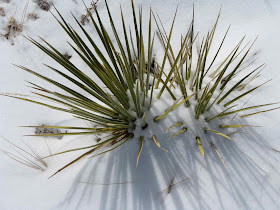 |
| After an early-morning safari shooting yucca flowers, breakfast is ready. |
Yucca petals are edible, and while I don’t find usually find wild harvest to be worth the time and effort (except for berries), I often eat petals when I walk though a yucca patch. They have a nice crunch to them, a mild appealing taste, and are large and easily plucked.
 |
I’m not the only creature that finds yucca petals tasty.
|
Even so, I wouldn’t rely on yucca flowers for a meal, and in truth, there was a more important reason for the expedition. It was a calm morning with barely a breeze, and the large heavy yucca flowers were perfectly still ... just the right conditions to try out my new macro lens.
I’m finding macro photography to be a work-in-progress and very much a learning experience. It seems experiment and trial-and-error are just as necessary as research. So far, the challenge and occasional pleasing results have compensated for frustration.
Outside with enough light, the Canon EF 100mm f/2.8L Macro IS USM on a Canon Rebel T3i seems to function well hand-held. Per many recommendations, I set the camera to aperture priority (Av) to control depth of field.
 |
| From Focusing Basics at Exposure Guide, a very helpful site. |
 |
Shallow depth-of-field blurs the background, making this ladybug the star of the shot. I wish I had moved the leaf in front out of the way ... live and learn.
|
Below is a look inside a yucca flower. Note the darker green stigma, the receptive female organ where pollen is deposited for fertilization. It sits atop the three-lobed ovary with ovules (future seeds), and is surrounded by curious club-shaped stamens. These are the male pollen-producers, but their moment in the sun is over -- the anthers have shriveled or fallen off (yellowish spots at tips).
There are ca 50 species of yucca, all native to North America. Great Plains yucca is the most northerly, growing into southern Alberta. |
The hardy Great Plains yucca, Yucca glauca, has no problem with Wyoming winters.
|
Almost all yuccas are pollinated by a specific kind of moth, though whether they are strictly dependent on their particular moths is still debated. The yucca pollination system is a classic and oft-cited example of plant-pollinator interdependency and coevolution. Without yucca moths, yuccas can’t reproduce, nor can yucca moths reproduce without yuccas. But together, love works for all.
 |
| Yucca moth in a Great Plains yucca flower. Source: USDA Forest Service. |
The life of a yucca moth is short, focused entirely on reproduction. Males and females emerge from cocoons at the same time that their yuccas bloom. They flutter about, somehow arriving on schedule for a tryst among the petals. The male’s mission is thus accomplished, but for the female, there still is much to do. She collects pollen from the flower’s anthers, balls it up under her chin, and flies off to a different plant to lay eggs, doing the yucca a favor by ensuring out-crossing. When she finds a flower with no other moth eggs, she lays some (but not too many) eggs in the ovary, and then proceeds to do the necessary pollinating, placing a bit of her pollen load on the stigma. Pollination leads to fertilization and seed set, so her offspring will have something to eat when they hatch. It’s impressive how closely coordinated plant and pollinator behavior are, and just how well everything works. It’s especially wonderful that we have figured out enough to be able to enjoy the story ourselves.
 |
| Some of the yuccas have beautiful bicolored flowers. |
 |
| A look inside a flower -- six stamens surround the three-lobed stigma and ovary. |
Back at home, I took the next step. I put the camera on a borrowed tripod for even closer shots, but in spite of additional equipment, the results generally were not impressive. Perhaps insufficient lighting was a problem, or figuring out what to focus on for a given aperture (depth-of-field).
There was occasional success ... I like this accidental curious shot.
 |
| Yucca flower with scale, for the more scientifically-minded. |
Another peek into a flower ... not nearly as nice as those taken outside in natural light.
The flower below has not yet been visited by moths -- note the anthers are unopened. Sharper focus would have been nice.
In spite of limited success, I learned some neat things about my camera and lens, for example Live View mode (monitoring everything with the LCD panel) and using manual focus to refine auto focus. Fortunately, at this point the path is as intriguing as the destination.
 |
| Fun with gear. |
Sources (in addition to links in post)
Yuccas and yucca moths
Pellmyr, O. 2003. Yuccas, yucca moths, and coevolution: a review. Ann. Missouri Botanical Garden 90:35-55 http://www.jstor.org/stable/3298524
Sheppard, C.A. and Oliver, R.A. 2004. Yucca moths and yucca plants: discovery of “the Most Wonderful Case of Fertilisation”. American Entomologist 50:32-46. PDF
Macro photography
from Cambridge in Color
from Exposure Guide
from Kew Gardens







Thanks for sharing such lovely photos. I've never seen a yucca in flower before - you live in a magical place.
ReplyDeleteThanks, Tim, for your kind comments. I hope you get to meet a flowering yucca someday! :)
DeleteHi Erika -- the Rebel is a less expensive "entry level" DSLR, but wow ... it can do so much, as I'm still learning!
ReplyDeletethanks for reading ...
Hollis